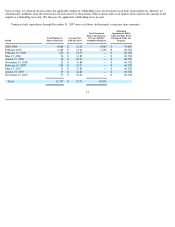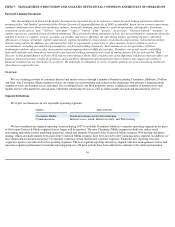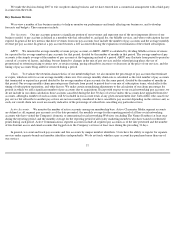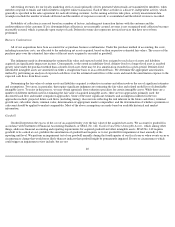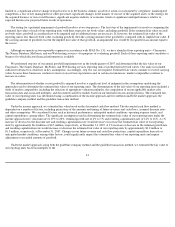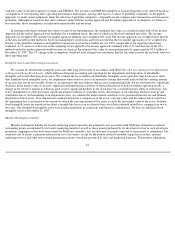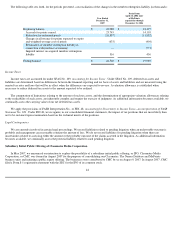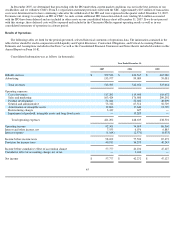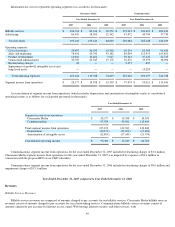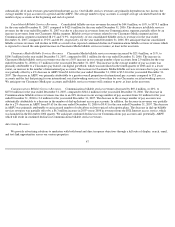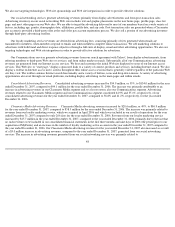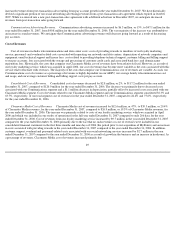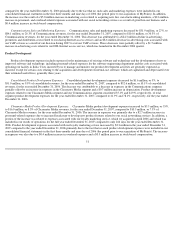Classmates.com 2007 Annual Report Download - page 44
Download and view the complete annual report
Please find page 44 of the 2007 Classmates.com annual report below. You can navigate through the pages in the report by either clicking on the pages listed below, or by using the keyword search tool below to find specific information within the annual report.
cash-free value of invested capital to revenues and EBITDA. The revenues and EBITDA multiples of our reporting units were selected based on
a comparison of our reporting units' operating performance and margins, among other factors, to those of guideline companies. In the market
approach, we made certain judgments about the selection of guideline companies, comparable recent company sales transactions and transaction
premiums. Although we based our fair value estimates under both the income approach and the market approach on assumptions we believe to
be reasonable, those assumptions are inherently unpredictable and uncertain.
In arriving at the final estimated fair values of each of our reporting units, the estimated fair values as calculated under both of the income
approach and the market approach were multiplied by a weighting factor, the sum of which was the final estimated fair value. The income
approach was weighted 50% and the two market approach methods were weighted 25% each. The income approach was weighted more heavily
as the data included in that method is based on management's projections and forecasts whereas the two market approaches were weighted less
heavily as the guideline companies and guideline transactions used in those models are not 100% comparable to our reporting units being
evaluated. A 1% increase or decrease in the weighting factor applied to the income approach combined with a 1% total decrease in the two
methods under the market approach would increase or decrease the estimated fair value of our reporting units by approximately $3.4 million at
December 31, 2007. The 1% change in the assumptions would not have changed our conclusion that the fair value exceeds the net book value for
these reporting units.
Intangible Assets and Other Long
-Lived Assets
We account for identifiable intangible assets and other long-lived assets in accordance with SFAS No. 144, Accounting for the Impairment
or Disposal of Long-Lived Assets , which addresses financial accounting and reporting for the impairment and disposition of identifiable
intangible assets and other long-lived assets. We evaluate the recoverability of identifiable intangible assets and other long-lived assets, other
than indefinite-lived intangible assets, for impairment when events occur or circumstances change that would indicate that the carrying amount
of an asset may not be recoverable. Events or circumstances that may indicate that an asset is impaired include, but are not limited to, significant
decreases in the market value of an asset, significant underperformance relative to expected historical or projected future operating results, a
change in the extent or manner in which an asset is used, significant declines in our stock price for a sustained period, shifts in technology, loss
of key management or other personnel, significant negative industry or economic trends, and changes in our operating model or strategy and
competitive forces. In determining if an impairment exists, we estimate the undiscounted cash flows to be generated from the use and ultimate
disposition of these assets. If an impairment is indicated based on a comparison of the assets' carrying values and the undiscounted cash flows,
the impairment loss is measured as the amount by which the carrying amount of the assets exceeds the fair market value of the assets. Definite-
lived intangible assets are amortized on either a straight-line basis or an accelerated basis over their estimated useful lives, ranging from two to
ten years. Our identifiable intangible assets were acquired primarily in connection with business combinations. We have no indefinite-lived
intangible assets at December 31, 2007.
Member Redemption Liability
Member redemption liability for loyalty marketing points represents the estimated costs associated with MyPoints' obligation to redeem
outstanding points accumulated by its loyalty marketing members as well as those points purchased by its advertisers for use in such advertisers'
promotion campaigns as they have been earned by MyPoints' members, less an allowance for points expected to expire prior to redemption. The
estimated cost of points is primarily presented in cost of revenues, except for the portion related to member acquisition activities, internal
marketing surveys and other non-revenue generating activities which are presented in sales and marketing expenses. The member redemption
42



